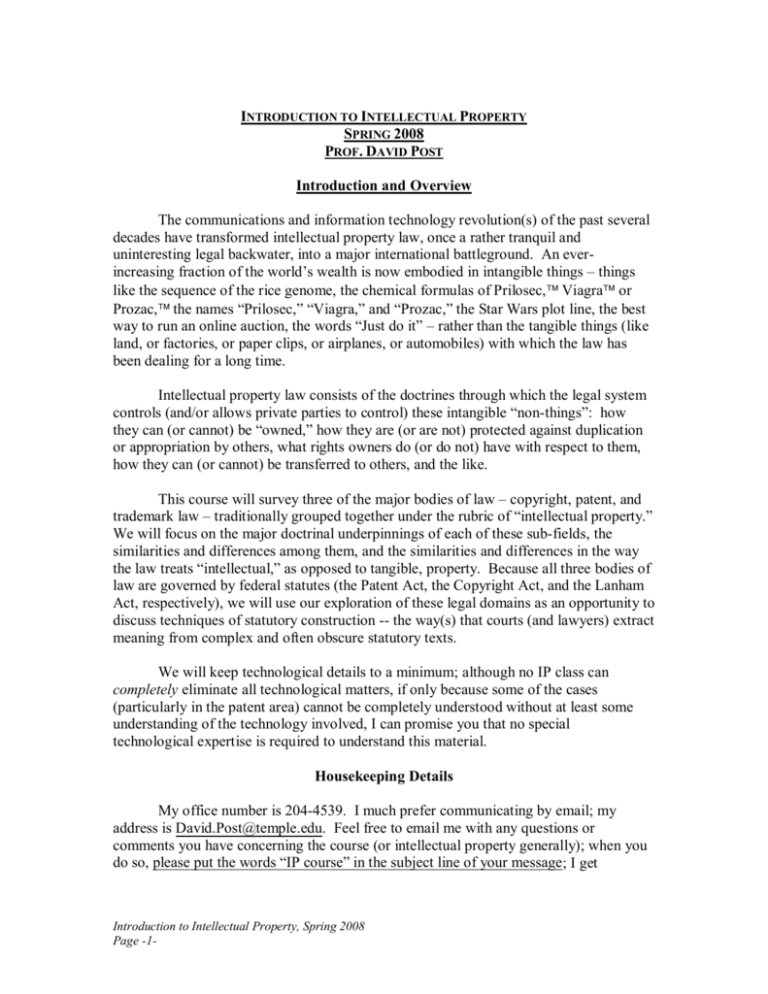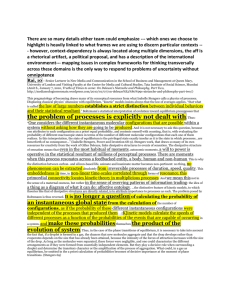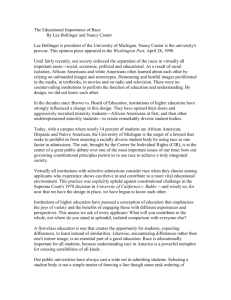Introduction and Overview The communications and information
advertisement

INTRODUCTION TO INTELLECTUAL PROPERTY SPRING 2008 PROF. DAVID POST Introduction and Overview The communications and information technology revolution(s) of the past several decades have transformed intellectual property law, once a rather tranquil and uninteresting legal backwater, into a major international battleground. An everincreasing fraction of the world’s wealth is now embodied in intangible things –things like the sequence of the rice genome, the chemical formulas of Prilosec, Viagra or Prozac, the names “Prilosec,”“Viagra,”and “Prozac,”the Star Wars plot line, the best way to run an online auction, the words “Just do it”–rather than the tangible things (like land, or factories, or paper clips, or airplanes, or automobiles) with which the law has been dealing for a long time. Intellectual property law consists of the doctrines through which the legal system controls (and/or allows private parties to control) these intangible “non-things”: how they can (or cannot) be “owned,”how they are (or are not) protected against duplication or appropriation by others, what rights owners do (or do not) have with respect to them, how they can (or cannot) be transferred to others, and the like. This course will survey three of the major bodies of law –copyright, patent, and trademark law –traditionally grouped together under the rubric of “intellectual property.” We will focus on the major doctrinal underpinnings of each of these sub-fields, the similarities and differences among them, and the similarities and differences in the way the law treats “intellectual,”as opposed to tangible, property. Because all three bodies of law are governed by federal statutes (the Patent Act, the Copyright Act, and the Lanham Act, respectively), we will use our exploration of these legal domains as an opportunity to discuss techniques of statutory construction -- the way(s) that courts (and lawyers) extract meaning from complex and often obscure statutory texts. We will keep technological details to a minimum; although no IP class can completely eliminate all technological matters, if only because some of the cases (particularly in the patent area) cannot be completely understood without at least some understanding of the technology involved, I can promise you that no special technological expertise is required to understand this material. Housekeeping Details My office number is 204-4539. I much prefer communicating by email; my address is David.Post@temple.edu. Feel free to email me with any questions or comments you have concerning the course (or intellectual property generally); when you do so, please put the words “IP course”in the subject line of your message; I get Introduction to Intellectual Property, Spring 2008 Page -1- hundreds of emails a day, and if I know that a particular email is from a student in this class I am much more likely to read it, and to respond to it, expeditiously. My office is in room 622 (Klein), and my office hours are Mondays, 4-5 PM, and Thursdays, 12:00 –3. I’m always happy to set up an appointment to meet with you at other times if these are not convenient, and you should feel free to drop in if I’m around my office at other times. There will be a 3 ½ HOUR OPEN BOOK IN-CLASS EXAMINATION, consisting of around 10 –15 short essay questions (one or two paragraphs each). I will distribute previously-given exams in this format, and we will have ample opportunity during the semester to look at those exams and to discuss the ways in which the questions should (and should not) be answered. I expect all students to attend all classes. Our class meeting is a professional obligation of yours (and of mine). I understand that there may be occasions when you can’t make it to class for one reason or another, just as there may be occasions when I can’t make it to class for one reason or another. If I am unable to make it to class, I will do my best to let you know beforehand; if you are unable to make it to class, please do me the reciprocal courtesy and do your best to let me know beforehand. I also expect all of you, obviously, to do the reading for each class; you will get very little (or, more probably, nothing at all) out of the class discussion if you do not. Beginning the second week of classes, I will assign each of you to a group that will have special responsibility for a particular week’s reading, and I will call upon members of that group during class to keep the discussion going. Class participation from everyone is encouraged, but is not graded. BOOKS All readings are from the Course Packet (available from the Distribution Center) and the 2007 Statutory Supplement (Merges, Menell and Lemley, ”2007 Statutory Supplement to Intellectual Property in the New Technological Age”), available at the Bookstore. The Supplement is not optional; you must get in the habit of having the statutory text in front of you at all times when reading these cases. Whenever you encounter a statutory reference in the readings below, read the relevant statutory section in the Supplement. We will get all the law we need from the cases in the Course Packet (and the statutory material in the Supplement). I have ordered copies of two additional “recommended”texts: Merges and Ginsburg, “Foundations of Intellectual Property,”and Ginsburg and Dreyfuss, Eds., “Intellectual Property Stories.” The first is a good, relatively inexpensive “hornbook”; those of you who like to have a summary overview of the field of law you are studying might find it helpful. The second is a compilation of background material pertaining to many of the “major”IP cases that we will be studying over the course of the semester, and provides useful and interesting context for the court Introduction to Intellectual Property, Spring 2008 Page -2- opinions in those cases. Neither book is required in any sense, and there will be no assigned readings from either of them. This course, like all courses at the law school, is governed by Temple’s policy on Student and Faculty Academic Rights and Responsibilities (Policy # 3.70.02), which can be accessed through the following link: http://policies.temple.edu/getdoc.asp?policy_no=03.70.02. READINGS –PART ONE I. INTRODUCTORY MATERIAL Class 1 [Jan 15] Nadel v. Play-by-Play Toys, 208 F.3d 368 (2d Cir. 2000) Lueddecke v. Chevrolet Motors, 70 F.2d 345 (8th Cir. 1934) Class 2 [Jan. 17] Metallurgical Industries v. Fourtek, 790 F.2d 1195 (5th Cir. 1986) II. COPYRIGHT LAW Class 3 [Jan. 22] US Constitution, Art 1 section 8 Eldred v. Ashcroft, 537 US 186 (2003) Class 4 [Jan 24] Copyright Act §§ 101 (as needed), 102 –103 Bell v. Catalda, 191 F.2d 99 (2d Cir. 1951); [plus excerpt of facts from district court opinion, Bell v. Catalda, 74 F. Supp. 973 (SDNY 1947)] Feist Publications, Inc. v. Rural Telephone Service Co., 499 U.S. 340 (1991) Class 5 [Jan 29] Burrough-Giles Lithographic Co. v. Sarony, 111 U.S. 53 (1884) Rockford Map Publishers, Inc. v. Directory Service Co., 768 F.2d 145 (7th Cir. 1985) Class 6 [Jan 31] Introduction to Intellectual Property, Spring 2008 Page -3- Baker v. Selden, 101 U.S. 99 (1879) Copyright Act, §§ 201, 202, 204 Andrien v. Southern Ocean County Chamber of Commerce, 927 F.2d 132 (3d Cir. 1991) Class 7 [Feb 5] Community for Creative Non-Violence v. Reid, 490 U.S. 730 (1989) Childress v. Taylor, 945 F.2d 500 (2d Cir. 1991) Class 8 [Feb 7] Copyright Act, §§106, 109(a) and 109(c) H.R. Report No 94-1476, 94th Cong. 2d Sess. 61 –65 (1976) Columbia Pictures v. Redd Horne, 749 F.2d 154 (3d Cir. 1984) Sheldon v. Metro-Goldwyn Pictures Corp., 81 F.2d 49 (2d Cir. 1936) Class 9 [Feb 12] 28 U.S.C. §§ 1331, 1332, and 1338 Copyright Act, §§ 501(a), 501(b), 502 –507 Arnstein v. Porter, 154 F.2d 464 (2d Cir. 1946) Selle v. Gibb, 741 f.2d 896 (7th Cir. 1984) Class 10 [Feb 14] Gross v. Seligman, 212 Fed. 930 (2d Cir. 1914) Steinberg v. Columbia Pictures, 663 F.Supp. 706 (SDNY 1987) Class 11 [Feb 19] Copyright Act, §107, 108, 110 Harper & Row v. Nation Enterprises, 471 U.S. 539 (1985) Campbell v. Acuff Rose, 510 U.S. 569 (1994) Class 12 [Feb 21] Am. Geophysical Union v. Texaco, 60 F.3d 913 (2d Cir. 1994) Class 13 [Feb 26] COPYRIGHT REVIEW –NO NEW READING Introduction to Intellectual Property, Spring 2008 Page -4- III. PATENT LAW Class 16 [March 6] Patent Act §§ 100, 101 SKIM Patent Number 6,328,163 (Morphing Candy Holding Device) Diamond v. Chakrabarty, 447 US 303 (1980) 28 U.S.C. § 1295 SKIM Patent Act, §§ 110 –116 SPRING BREAK Class 17 [March 18] Patent Act §102 Pennock v. Dialogue, 2 Pet. 1 (1829) Application of Borst, 345 F.2d 851 (CCPA, 1965) Rosaire v. National Lead Co. 218 F.2d 72 (5th Cir. 1955) Class 18 [March 20] In re Hall 781 F.2d 897 (Fed. Cir. 1986) In re Cronyn, 890 F.2d 1158 (Fed. Cir. 1989) Mahurkar v. Bard, 79 F.3d 1572 (Fed. Cir. 1996) Class 19 [March 25] Egbert v. Lippmann, 104 US 333 (1881) Metallizing Engineering Co v. Kenyon Bearing & Auto Parts, 153 F.2d 516 (2d Cir. 1946) Class 20 [March 27] TP Laboratories v. Professional Positioners, Inc., 724 F.2d 965 (Fed. Cir. 1984) Pfaff v Wells Electronic, 525 US 55 (1998) Lough v Brunswick, 86 F.3d 1113 (Fed. Cir. 1996) Class 21 [April 1] Patent Act §103(a) Hazeltine Research v. Brenner, 382 US 252 (1965) HANDOUT: KSR v Teleflex, __ U.S. __ (2007) Class 22 [April 3] Introduction to Intellectual Property, Spring 2008 Page -5- Patent Act §§ 154 and 271 Larami Corp. v. Amron, 27 USPQ 2d 1280 (ED Pa 1993) Class 23 [April 8] Graver Tank v. Linde Air Products, 339 US 605 (1950) Warner-Jenkinson v. Hilton Davis, 520 US 17 (1997) Class 24 [April 10] Patent Review –NO NEW READING IV. TRADEMARK LAW CLASS 25 [APRIL 15] Qualitex Co. v. Jacobson Products Co., 514 U.S. 159 (1995) Blue Bell, Inc. v. Farah Manufacturing Co., 508 F.2d. 1260 (5th Cir. 1975) Class 26 [April 17] Zatarain’s Inc. v. Oak Grove Smokehouse, Inc. 698 F.2d 786 (5th Cir. 1983) Class 27 [April 22] King-Seely Thermos Co. v. Aladdin Industries, Inc., 418 F.2d 31 (2d Cir. 1969) McGregor-Doniger, Inc. v. Drizzle, Inc., 599 F.2d 1126 (2d Cir. 1979) Class 28 [April 24] Review –NO NEW READING Introduction to Intellectual Property, Spring 2008 Page -6-




